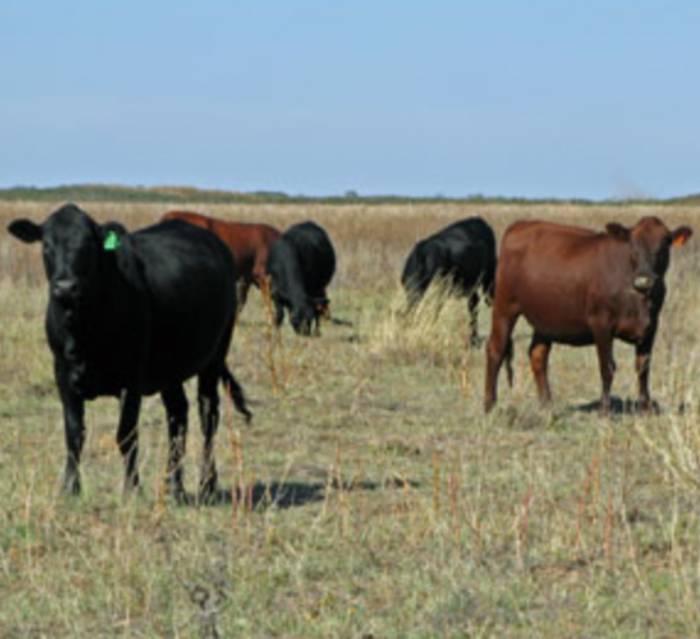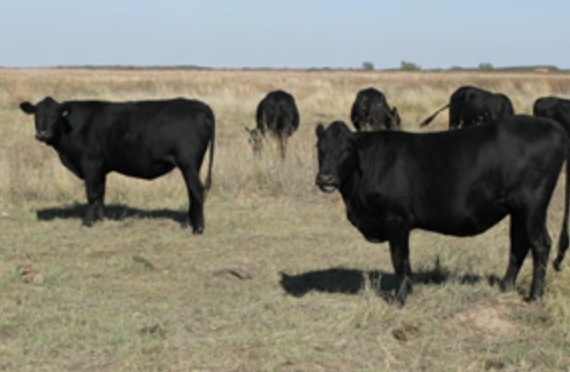Mashona Cattle
Also Known As: Makalanga, Makaranga, Ngombe dza Vakaranga, Shona Mashuk, Mashukulumbwe
Mashona cattle originated from the Shona people of eastern Zimbabwe. They are bred in a wide spreading territory covering most of the eastern half of Zimbabwe and an adjoining region of Mozambiquethat is free of the tsetse fly. The Mashona cattle are of the Sanga type. Following the decimation in the Shona herds caused by the cattle plague of 1896-98 and the East Coast fever epidemic of 1900-1906 larger number of mainly Angonis cows were mated with Mashona bulls.

This breed is reared for meat production and it is said they make docile working animals. A herd book was established in 1954, after a decade of selection for beef production and polled characteristics (hornless). The breed is usually black or red and most are now polled. The mature weight of the breed ranges from 600 - 775 pounds.
Figure 1. Image provided by American Mashona.
History and description
Indigenous cattle of varying types found throughout the length and breadth of Africa, but only since the turn of the present century has any attempt been made to study and classify them. Because of the dearth of reliable evidence and the general lack of historical records in Africa, the conclusions arrived at must be regarded as somewhat speculative.
Although the indigenous cattle of Africa generally lack uniformity of type, they may be placed in the following five main groups:
The Humpless Longhorn Cattle
These were the original cattle of North Africa as illustrated in paintings in the tombs of Egypt 7,000 years ago, but are today only found in West Africa.
The Humpless Shorthorn Cattle
These begin to be depicted in the Egyptian tombs from about 2500 BC from which time they obviously displaced the longhorns to the south and west. The cattle of the Mediterranean region today are mainly of this type.
The Neckhumped Lateral-horned Zebu
There are records of this type of humped cattle from the old civilizations north of the Persian Gulf and later records, about 1500 BC, of their appearance in Egypt. It is thought that they may have entered at the "horn" of Africa and become established in Ethiopia, from once they spread north and south. Today, however, they are only represented by the Afrikaner breed which was developed from Khoi Khoi cattle which the early settlers found at the Cape.
The Chesthumped Shorthorn Zebu
This appears to be the most recent type to enter the continent and evidence indicates that is was introduced down the East Coast by Arab and Indian Traders from about the middle of the seventh century A.D. It is now the dominant type in East and Central Africa.
The Sanga Cattle
This type is widely spread in South, Central and West Equatorial Africa and is obviously the result of crossbreeding between the original humpless cattle and the invading zebus. They are usually neckhumped but vary greatly in the size and shape of the horns. The indigenous breeds of Zimbabwe fall into this group.
As the migrating Bantu tribes moved down the continent they took their cattle for
them, crossing the Zambezi about 700 AD Portuguese explorers reported the presence
of cattle in what we now know as Zimbabwe in the 16th Century, and the first white
settlers found large numbers of stock, estimated at 500,000 in the hands of the local
inhabitants. They were distributed mainly along the central plateau, which was free
of tsetse fly.
The cattle which the pioneering settlers found were almost exclusively of the Sanga type. They were neck-humped, small in stature, rounded in appearance with sloping rumps, their coats were sleek and shiny, they were fine of bone, had small, broad alert heads and long thin, active tails. The horns in the cow curved outward and forwards and were round and fine in cross-section.
The horns in the bull were also rounded but shorter and heavier, curving out and upwards. The horns in the oxen were longer and more widespread. A few of the animals were naturally polled. Color patterns were many and varied. The predominant color was black followed by reds and browns, with yellows and duns being less common. These colors were often accompanied by white patches or stipples very broken in outline. Black and red were frequently mixed giving rise to variations of the attractive M'Sundu pattern or more rarely the brindle (Nhuru).
In, 1896, disaster struck in the form of the Rinderpest epizootic which swept down from the north killing cattle and antelope alike; to be followed a few years later by the introduction of East Coast Fever from Macambiqu. The herds were decimated and by the time these diseases were under control it was estimated that only 50,000 head remained in the century.
To help build up numbers again, cattle were introduced from Zambia. They were mostly cows and were probably Angoni type shorthorn Zebus, but it is not known what lasting genetic influence they had on the native herds. From about this time both Government and private individuals began importing bulls from South Africa and overseas with which to grade-up and "improve" the indigenous stock. In most instances this process led to indiscriminate crossbreeding, without any corresponding improvement in management and resulted in heterogeneous, degenerate animals completely lacking the desirable characteristics of their parent stock.
The indigenous breeds which exist in Zimbabwe today, the Mashona, Nkone and Tuli have developed from this original stock. As might be expected there are close genetic similarities, especially between the Mashona and Nkone, but surveys of transferring types and estimated hemoglobin gene frequencies from herds throughout the century have shown that animals do in fact all in fact fall into distinct breed groups. It can be speculated, however that all the original genotypes must have been Mashonas.

Figure 2. Image provided by American Mashona.
The Nkone cattle have descended from the cattle belonging to the a'Mandebele tribe which settled in Matebeleland in 1838. The largest concentrations of these animals are found in the Gwaii and neighboring communal areas in the western part of Zimbabwe. A small breeding herd was established at Tjolotjo, approximately 130 km northwest of Bulawayo in 1946, and this subsequently grew to become the main center of research and developed of the breed. A second herd was established at Msengenzi Experiment Farm in the Makwiro district of Mashonaland in 1953, and the Nkone Cattle Club was established with a number of commercial breeders in the early 1960's.
In 1942, Mr. Len Harvey, who was a land development officer, noticed a distinct yellow type of animal in the indigenous herds in the low veld south of Gwanda. Government subsequently decided to purchase some of these cattle to see if the type could be improved, and established the Lowveld Cattle Breeding Station with Mr. Harvey as Officer-in-Charge. This became the center of work on the breed and became known as the Tuli Breeding Station. Commercial breeders became interested in the breed and an official Breed Society was informed in 1961.
Prior to 1890, Thomas Baines, the explorer and big game hunter, recorded that he obtained "two little cows which being from Mashonaland were excellent milkers." However, probably the first serious written record on Mashona cattle was contained in a letter written by a member of the Pioneer Column, Mr. Jack Carruthers Smith, to Mr. Frank Willoughby. In it, he wrote:
"My first experience of Mashona cattle was in the beginning of 1891 until the end of March 1897, when I left for Bulawayo in Matabeleland. I considered Mashona cattle a distinctive breed of their own. They were a very small breed, with very small and fine bone, very compact. They had lovely symmetrical horns. I should think about 70 percent of the cattle were jet black, 25 to 27 percent dark red, perhaps 1,5 percent dark yellow, probably 1 percent dun colored. Amongst the black, there was perhaps 1 or 2 percent hornless and in the red an odd hornless beast.
The true Mashona, as I remember it, had very short legs, bone very fine, a long thin tail, with a bush at the end of it, not unlike the bush on a lion's tail.
To the beast of my memory, the pure bred little Mashona gave 1 1/2 to 2 bottles of milk, at a milking.
I might add that the hair on the Mashona cattle was very short and simply shone, when in perfect condition, which in the early 1890's they generally were."
Meanwhile, in 1941, some forty years after these early recordings, and independently of each other, two dedicated men, Mr. F.B. Willoughby and Mr. E.A.B. McLeod began building up herds of indigenous cattle in Mashonaland. They visited dip-tanks in various remote communal areas and bought up animals which conformed to the characteristics which they had fixed in their minds. Mr. Willoughby obtained many of his foundation stock in the Chilimanzi and Buhera Communal lands. One polled bull in particular, which, as a three-month-old calf, walked the 200 miles from Buhera to Ellerton Farm, had a tremendous influence on the future Mashona breed. Mr. McLeod bought most of his original animals in the Mhonondoro area. He trekked them first to Gokwe and then to Essexvale as he was transferred, finally buying a farm in the latter district. He obtained some polled bulls from Ellerton and by small, black, hornless cattle of considerable hardiness and docility. The Ellerton herd was larger and more broadly based and although predominantly black, managed to perpetuate most of the color and color patterns of the native stock. Here again selection was based strictly upon the most desirable functional characteristics of the indigenous cattle, and over the years a remarkably productive herd was achieved.
The enthusiasm of these two men led to the founding of the Rhodesian Indigenous Cattle Society on the 16th of January, 1950, with Mr. Willoughby becoming the first President and Mr. McLeod as honorary secretary. A few years later the name was changed to the more specific Mashona Cattle Society.
The vision and enterprise of Messrs. Willoughby and McLeod have been more than justified, and while the breed today has a much broader genetic base than either may ever have visualized, their original bloodlines still run very strong in the modern Mashona.
References
Genus Bos: Cattle Breeds of the World, 1985, MSO-AGVET (Merck & Co., Inc.), Rahway, N.J.
Mason, I.L. 1996. A World Dictionary of Livestock Breeds, Types and Varieties. Fourth Edition. C.A.B International. 273 pp.
Jim Weaver, Weaver Ranch, P.O. Box 23, Causey, New Mexico 88113
